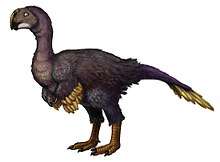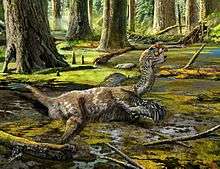Nanxiong Formation
The Nanxiong Formation (also known as Yuanpu Formation) is a Late Cretaceous geologic formation in Guangdong Province. Dinosaur remains are among the fossils that have been recovered from the formation. It consists of continental siliciclastic red beds, with fauna which similar to that of the Nemegt Formation. It has been dated about 66.7 ± 0.3 million years ago.[1] It is the lowest unit of the Nanxiong Basin, a small graben created during Mesozoic rifting.[2] Buck et al state that it overlies Jurassic granite basement, and is conformably overlain by the Shanghu Formation.[1] Alternative stratigraphic schemes for the Nanxiong basin have been proposed,[3] one of which refers to the Nanxiong succession as the Nanxiong Group, and dividing it into the Yuanfu, Zhutian and Zhenshui formations, and overlying the Albian to Turonian Changba Formation.[4]
| Nanxiong Formation Stratigraphic range: Maastrichtian, 66.7 Ma | |
|---|---|
| Type | Geological formation |
| Underlies | Shanghu Formation |
| Overlies |
|
| Thickness | ~300 m (Buck et al 2004) Several kilometers (Nanxiong Group, Xing et al 2017) |
| Lithology | |
| Primary | Sandstone, siltstone, mudstone |
| Other | Limestone, conglomerate |
| Location | |
| Coordinates | 23.5°N 114.9°E |
| Approximate paleocoordinates | 23.8°N 110.5°E |
| Region | Guangdong Province |
| Country | |
| Extent | Nanxiong Basin |
 Nanxiong Formation (China)  Nanxiong Formation (Guangdong) | |
Paleofauna
Dinosaurs
Theropods
| Theropods | ||||||
|---|---|---|---|---|---|---|
| Genus | Species | Material | Notes | Images | ||
| Banji[5] |
B. long |
Nearly complete skull and lower jaw. |
An oviraptorid. |
 Restoration | ||
| Corythoraptor[6] |
C. jacobsi |
Nearly complete skeleton including the skull and lower jaw. |
An oviraptorid with a distinct cassowary-like crest. |
 Restoration | ||
| Ganzhousaurus[7] |
G. nankangensis |
Lower jaw, leg bone, hip bone and caudal vertebrae. |
A transitional oviraptorid with both basal and derived traits. |
 Restoration | ||
| Huanansaurus[8] |
H. ganzhouensis |
Nearly complete skull, lower jaws, neck vertebrae, a humerus, arm fragments, lower part of the right thighbone, the upper part of the right shinbone, and parts of the right foot. |
An oviraptorid. |
 Restoration | ||
| Indeterminate oviraptorid[9] |
Indeterminate |
A female individual preserving the pelvic girdle, some caudals and two eggs inside the abdominal cavity.[9] |
An oviraptorid. |
|||
|
J. ganzhouensis |
Incomplete skull, lower jaw, vertebrae, nearly complete pectoral girdle, the left forelimb, ribs, and a partially preserved pelvic girdle. |
An oviraptorid. |
 Restoration | |||
|
Macroolithus sp.[11] |
Indeterminate |
Five egg clutches containing over 60 eggs.[11] |
Oviraptorid eggs. |
 Egg clutches | ||
|
N. jiangxiensis |
A partial lower jaw, vertebrae, both scapulocoracoids, a nearly complete right humerus, pubic bones, and some dorsal ribs. |
An oviraptorid. |
 Restoration | |||
| Nanshiungosaurus[13] |
N. brevispinus |
Eleven cervical vertebrae, ten dorsal vertebrae, six sacral vertebrae and the pelvis. |
 Restoration | |||
| Qianzhousaurus[15] |
Q. sinensis |
A skull, lower jaw, vertebrae, both scapulocoracoids, a left femur and a left tibia. |
A tyrannosaurid, could represent a third species of Alioramus.[16] |
 Restoration | ||
|
S. oblita |
Sparce postcranial remains lacking the skull. |
An oviraptorid. |
||||
|
Indeterminate |
A maxillary tooth that differs from tyrannosaurid and carcharodontosaurid dentition. |
A notably large theropod. |
||||
|
T. limosus |
Almost complete skeleton, portions of the arms, right leg, and tail were destroyed by TNT blasts. |
An oviraptorid, the pose indicates that it may have died trying to free itself from mud. |
 Speculative death conditions | |||
|
Tyrannosauridae indet.[13][18] |
Indeterminate |
|||||
Ornithopods
| Ornithopods | ||||||
|---|---|---|---|---|---|---|
| Genus | Species | Material | Notes | Images | ||
|
M. nanshiungensis |
Partial lower jaw from a juvenile that was about 2.6 m long |
A nomen dubium hadrosaur taxon.[4] |
||||
| Hadrosauropodus isp.[4] |
Indeterminate |
Three-toed footprints.[4] |
A hadrosaur. |
|||
Sauropods
| Sauropods | ||||||
|---|---|---|---|---|---|---|
| Genus | Species | Material | Notes | Images | ||
| Gannansaurus[20] |
G. sinensis |
A single, nearly complete dorsal vertebra and a mid-caudal vertebra. |
A sauropod closely related to Euhelopus. |
|||
Other reptiles
Turtles
| Turtles | ||||||
|---|---|---|---|---|---|---|
| Genus | Species | Material | Notes | Images | ||
| Jiangxichelys[21] |
J. ganzhouensis |
A complete shell. |
A nanhsiungchelyid turtle |
|||
| Nanhsiungchelys[22] |
N. wuchingensis |
A partial skeleton. |
A nanhsiungchelyid turtle.[23] |
|||
|
O. elongatus, O. nanhsiungensis, O. rugustus and O. spheroides. |
Egg and egg clutches. Some of these were probably laid by Nanhsiungchelys.[13][23] |
Turtle and/or theropod eggs. |
.jpg) Oolithes spheroides | |||
Crocodilians
| Crocodilians | ||||||
|---|---|---|---|---|---|---|
| Genus | Species | Material | Notes | Images | ||
| Jiangxisuchus[24] |
J. nankangensis |
Nearly complete skull and mandible. |
||||
Lizards
| Lizards | ||||||
|---|---|---|---|---|---|---|
| Genus | Species | Material | Notes | Images | ||
| Chianghsia[25] |
C. nankangensis |
A partial skull and lower jaws. |
A monstersaurian lizard |
|||
| Tianyusaurus[26] |
T. zhengi |
A skull, mandible, first eight cervical vertebrae and nearly complete pectoral girdles. |
A polyglyphanodontian lizard, also known from the Qiupa Formation |
 Holotype skull | ||
Color key
|
Notes Uncertain or tentative taxa are in small text; |
See also
- List of dinosaur-bearing rock formations
- Dalangshan Formation
References
- Buck, B. J.; Hanson, A. D.; Hengst, R. A.; Shu-sheng, H. (2004). ""Tertiary Dinosaurs" in the Nanxiong Basin, Southern China, Are Reworked from the Cretaceous". The Journal of Geology. 112 (1): 111–118. Bibcode:2004JG....112..111B. doi:10.1086/379695.
- Lucas, Spencer G.; Kirkland, James I.; Estep, John W. (1998). "Vertebrate biostratigraphy and biochronology of the Cretaceous of China". Lower and Middle Cretaceous Terrestrial Ecosystems: Bulletin 14. New Mexico Museum of Natural History and Science. p. 14.
- Yan, Yi; Xia, Bin; Lin, Ge; Cui, Xuejun; Hu, Xiaoqiong; Yan, Pin; Zhang, Faqiang (April 2007). "Geochemistry of the sedimentary rocks from the Nanxiong Basin, South China and implications for provenance, paleoenvironment and paleoclimate at the K/T boundary" (PDF). Sedimentary Geology. 197 (1–2): 127–140. doi:10.1016/j.sedgeo.2006.09.004. ISSN 0037-0738.
- Xing, L.; Lockley, M. G.; Li, D.; Klein, H.; Ye, Y.; Scott Persons IV, W.; Ran, H. (2017). "Late Cretaceous ornithopod-dominated, theropod, and pterosaur track assemblages from the Nanxiong Basin, China: New discoveries, ichnotaxonomy, and paleoecology" (PDF). Palaeogeography, Palaeoclimatology, Palaeoecology. 466: 303−313. Bibcode:2017PPP...466..303X. doi:10.1016/j.palaeo.2016.11.035.
- Xu, X.; Han, F.-L. (2010). "A new oviraptorid dinosaur (Theropoda: Oviraptorosauria) from the Upper Cretaceous of China". Vertebrata PalAsiatica. 48 (1): 11–18.
- Lü, J.; Li, G; Kundrát, M.; Lee, Y.; Zhenyuan, S.; Yoshitsugu, K.; Caizhi, S.; Fangfang, T.; Hanfeng, L (2017). "High diversity of the Ganzhou Oviraptorid Fauna increased by a new "cassowary-like" crested species". Scientific Reports. 7 (1): 6393. Bibcode:2017NatSR...7.6393L. doi:10.1038/s41598-017-05016-6. PMC 5532250. PMID 28751667.
- Wang, S.; Sun, C.; Sullivan, C.; Xu, X. (2013). "A new oviraptorid (Dinosauria: Theropoda) from the Upper Cretaceous of southern China". Zootaxa. 3640 (2): 242–57. doi:10.11646/zootaxa.3640.2.7. PMID 26000415.
- Lü, Junchang; Pu, Hanyong; Kobayashi, Yoshitsugu; Xu, Li; Chang, Huali; Shang, Yuhua; Liu, Di; Lee, Yuong-Nam; Kundrát, Martin; Shen, Caizhi (2015). "A New Oviraptorid Dinosaur (Dinosauria: Oviraptorosauria) from the Late Cretaceous of Southern China and Its Paleobiogeographical Implications". Scientific Reports. 5 (11490): 11490. Bibcode:2015NatSR...511490L. doi:10.1038/srep11490. PMC 4489096. PMID 26133245.
- Sato, T.; Cheng, Y.-N.; Wu, X.-C.; Zelenitsky, D. K.; Hsiao, Y.-F. (2005). "A Pair of Shelled Eggs Inside A Female Dinosaur". Science. 308 (5720): 375–375. doi:10.1126/science.1110578. PMID 15831749.
- Wei Xuefang; Pu Hanyong; Xu Li; Liu Di; Lü Junchang (2013). "A New Oviraptorid Dinosaur (Theropoda: Oviraptorosauria) from the Late Cretaceous of Jiangxi Province, Southern China". Acta Geologica Sinica (English Edition). 87 (4): 899–904. doi:10.1111/1755-6724.12098.
- Yang, T.-R.; Wiemann, J.; Xu, L.; Cheng, Y.-N.; Wu, X.-C.; Sander, P. M. (2019). "Reconstruction of oviraptorid clutches illuminates their unique nesting biology". Acta Palaeontologica Polonica. 466: 581−596. doi:10.4202/app.00497.2018.
- Lü, J.; Yi, L.; Zhong, H.; Wei, X. (2013). Dodson, Peter (ed.). "A New Oviraptorosaur (Dinosauria: Oviraptorosauria) from the Late Cretaceous of Southern China and Its Paleoecological Implications". PLoS ONE. 8 (11): e80557. Bibcode:2013PLoSO...880557L. doi:10.1371/journal.pone.0080557. PMC 3842309. PMID 24312233.
- Dong, Z. (1979). "Cretaceous dinosaur fossils in southern China" [Cretaceous dinosaurs of the Huanan (south China)]. In Institute of Vertebrate Paleontology and Paleoanthropology; Nanjing Institute of Paleontology (eds.). Mesozoic and Cenozoic Redbeds in Southern China (in Chinese). Beijing: Science Press. pp. 342–350. Translated paper
- Zanno, L. E. (2010). "A taxonomic and phylogenetic re-evaluation of Therizinosauria (Dinosauria: Maniraptora)". Journal of Systematic Palaeontology. 8 (4): 503–543. doi:10.1080/14772019.2010.488045.
- Lü, Junchang; Yi, Laiping; Brusatte, Stephen L.; Yang, Ling; Li, Hua; Chen, Liu (2014). "A new clade of Asian Late Cretaceous long-snouted tyrannosaurids". Nature Communications. 5: 3788. Bibcode:2014NatCo...5.3788L. doi:10.1038/ncomms4788. PMID 24807588.
- Carr, Thomas D.; Varricchio, David J.; Sedlmayr, Jayc C.; Roberts, Eric M.; Moore, Jason R. (2017). "A new tyrannosaur with evidence for anagenesis and crocodile-like facial sensory system". Scientific Reports. 7: 44942. Bibcode:2017NatSR...744942C. doi:10.1038/srep44942. PMC 5372470. PMID 28358353.
- Lü, J. C.; Zhang, B. K. (2005). "A new oviraptorid (Theropoda: Oviraptorosauria) from the Upper Cretaceous of the Nanxiong Basin, Guangdong Province of southern China". Acta Palaeontologica Sinica. 44: 412−422.
- Mo, J.-Y.; Xu, X. (2015). "Large theropod teeth from the Upper Cretaceous of Jiangxi, southern China" (PDF). Vertebrata PalAsiatica. 53 (1): 63−72.
- Lü, J.; Chen, R.; Brusatte, S.L.; Zhu, Y.; Shen, C. (2016). "A Late Cretaceous diversification of Asian oviraptorid dinosaurs: evidence from a new species preserved in an unusual posture". Scientific Reports. 6: 35780. Bibcode:2016NatSR...635780L. doi:10.1038/srep35780. PMC 5103654. PMID 27831542.
- Junchang Lü; Laiping Yi; Hui Zhong; Xuefang Wei (2013). "A New Somphospondylan Sauropod (Dinosauria, Titanosauriformes) from the Late Cretaceous of Ganzhou, Jiangxi Province of Southern China". Acta Geologica Sinica (English Edition). 87 (3): 678–685. doi:10.1111/1755-6724.12079.
- Haiyan Tong; Jinyou Mo (2010). "Jiangxichelys, a new nanhsiungchelyid turtle from the Late Cretaceous of Ganzhou, Jiangxi Province, China". Geological Magazine. 147 (6): 981–986. Bibcode:2010GeoM..147..981T. doi:10.1017/S0016756810000671. Archived from the original on 11 July 2011. Retrieved 14 January 2011.
- H.-k. Yeh. 1966. A new Cretaceous turtle of Nanhsiung, northern Kwangtung. Vertebrata PalAsiatica
- Tong, H.; Li, L. (2019). "A revision of the holotype of Nanhsiungchelys wuchingensis, Ye, 1966 (Testudines: Cryptodira: Trionychoidae: Nanhsiungchelyidae)". Cretaceous Research. 95: 151−163. doi:10.1016/j.cretres.2018.11.003. hdl:311034/9424.
- Chun Li; Xiao-chun Wu; Scott Rufolo (2018). "A new crocodyloid (Eusuchia: Crocodylia) from the Upper Cretaceous of China". Cretaceous Research. 94: 25–39. doi:10.1016/j.cretres.2018.09.015.
- Mo, J. Y.; Xu, X.; Evans, S. E. (2012). "A large predatory lizard (Platynota, Squamata) from the Late Cretaceous of South China". Journal of Systematic Palaeontology. 10 (2): 333. doi:10.1080/14772019.2011.588254.
- Jun-chang Lü; Shu-an Ji; Zhi-ming Dong; Xiao-chun Wu (2008). "An Upper Cretaceous lizard with a lower temporal arcade". Naturwissenschaften. 95 (7): 663–669. Bibcode:2008NW.....95..663L. doi:10.1007/s00114-008-0364-1. PMID 18338150.